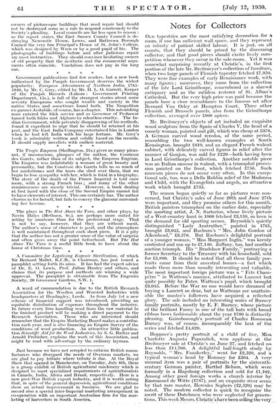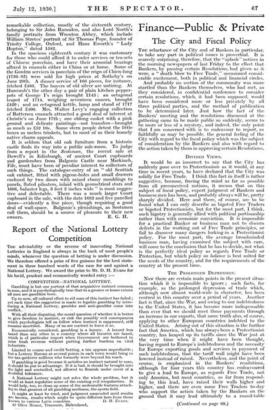Notes for Collectors
OLD tapestries are the most satisfying decoration -for a room, if one has sufficient wall space, and they represent an infinity of patient skilled labour. It is just, on all counts, that they should be prized by the discerning collector, and that good pieces should excite lively com- petition whenever they occur in the sale-room. Yet it was somewhat surprising recently at Christie's, in the first portion of the late Mr. Breitmeyer's collection of furniture, when two large panels of Flemish tapestry fetched £7,350. They were fine examples of early Renaissance work, with many figures ; moreover, they came from the collection of the late Lord Grimthorpe, remembered as a shrewd antiquary and as the ruthless restorer of St. Alban's Cathedral. But the very high price was paid because the panels bore a close resemblance to the famous set after Bernard Van Orley at Hampton Court. Three other Flemish and Brussels panels, also from the Grimthorpe collection, averaged over £800 apiece.
Mr. Breitmeyer's objects of art included an exquisite wood sculpture from the Spain of Charles V. the head of a comely woman, painted and gilt, which was cheap at £378. A German carved wood reredos, of the same period, resembling the two well-known examples at South Kensington, brought £819, and an elegant French walnut cabinet, with delicately carved figures in relief after the manner of Goujon, was sold for 4:220—both having been- in Lord Grimthorpe's collection. Another notable piece was an Italian cassone in walnut, with a triumphal proces- sion painted on the front, which fetched £754. Such museum pieces do not occur very often. In this excep- tional sale, too, was a Della Robbia relief of the Madonna and Child, with the Evangelists and angels, an attractive work which brought £735.
The season began quietly so far as pictures were con- cerned, but Christie's sales of June 20th and June 27th were important, and they promise others for this month. British painters triumphed on the earlier date, especially the sporting artist, J. N. Sartorius, whose lively picture of a West-country hunt in 1800 fetched £3,150, so keen is the demand for old sporting scenes. Reynolds's quietly distinguished "Lady Anstruther," painted in 1761, brought £3,045, and Raeburn's "Mrs. John Gordon of Ailienhead," £3,570. But Raeburn's delightful portrait of a younger woman, "Miss Margaret Inglis," was keenly contested and ran up to £7,140. Zoffany, too, had another auction triumph. IEs "Bradshaw Family," portraying a former Secretary to the Treasury with his household, sold for £5,880. It should be noted that all these family por-. traits came from their ancestral homes—a fact which made them more than usually interesting and valuable. The most important foreign picture was a "Fête Cham- p'etre ." in Watteau's manner, attributed to Lanes-et but quite possibly by Pater, 'Watteau's pupil, which brought' £3,045. Before the War no one would have dreamed of buying a Lancret so dear, but as Watteaus are unattain- able the master's followers, have acquired, a reflected glory. The sale included an interesting series of Burney family portraits, mostly by E. F. Burney, whose picture of the brilliant Fanny in one of the tall hats with broad ribbon bows fashionable about the year 1780 is distinctly pleasing. Gainsborough's portrait of Charles RousSeau Burney was, of course, incomparably the best of the series and fetched £4,620.
Hoppner's pretty portrait of a child of five, Miss Charlotte Augusta Papendiek, won applause at the l3reitmey-er sale at Christie's on June 27, and fetched no less than £14,700. A delightful half-length study by Reynolds, "Mrs. Fazakerley," went for £2,520, and a typical woman's head by Romney for £504. A very, unusual item was a pair of portraits by the sixteenth- century German painter, Barthel Beham, which were formerly in a Hapsburg collection and sold for £1,102.. Among other good foreign works a church interior by' Emmanuel de Witte (£787), and an exquisite river scene by that rare master, Hercules Seghers (f2,520) may be noted. The modern collector is quick to recognize the merit of these Dutchmen who were neglected for genera-, tions. This week Messrs. Christieshave beenselling the very remarkable collection, mostly of the sixteenth century, belonging to Sir John Ramsden, and also Lord North's family portraits from Wroxton _ Abbey, which include William Stretes' portrait of Sir _Thomas Pope, founder of Trinity College, Oxford, and Hans Eworth's "Lady Hopton," dated 1582. In the spacious eighteenth century it was customary• for those who could afford it to order services or tea-sets of Chinese porcelain, and have their armorial bearings affixed in enamels either in China or at home. Some of the Gordon services in porcelain of the reign of Chien-lung (1736-95) were sold for high prices at Sotheby's on June 20th. A dinner service of 166 pieces, for instance, fetched £483. The buyers of old silver are untiring. At Hurcomb's the other day a pair of plain kitchen pepper- pots of George I's reign brought £145; an octagonal teapot of 1714, weighing seventeen ounces, brought £420; and an octagonal kettle, lamp and stand of 1717 fetched 1400. Mrs. Walter Levy's engaging collection of Battersea enamels attracted a good deal of interest at Christie' S on June 17th; one oblong casket with a pink ground and delicate paintings—not transfers—brought as much as £52 10s. - Some stern people detest the little- boxes as useless trinkets, but to most of us their homely native charm appeals. It is seldom that old oak furniture from a historic castle finds its way into a public sale-room. To judge from a report in the Scotsman, the recent sale at Dowell's in Edinburgh, of ancient Court cupboards and garderobes from Balgonie Castle near Markinch, Fife, must have been of peculiar interest to collectors of such things. The catalogue-entry of an " old Scottish oak cabinet, fitted with pigeon-holes and small drawers enclosed by two doors with raised ebony mouldings to panels, fluted pilasters, inlaid with geometrical stars and 1606, baluster legs, 3 feet 2 inches wide" is most sugges- tive and delectable. There was a much larger Court cupboard in the sale, with the date 1682 and five panelled doors—evidently a fine piece, though requiring a good deal of wall-space. Balgonie's plenishings, as Scotsmen call them, should be a source of pleasure to their new





































 Previous page
Previous page